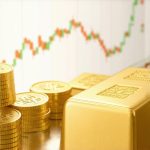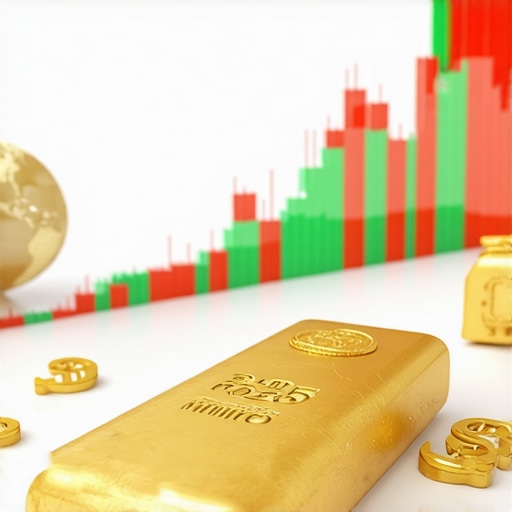Exploring the Dynamic Landscape of Gold Demand in 2025: A High-Level Perspective
As we navigate the complex macroeconomic environment of 2025, the demand for gold emerges as a critical indicator of financial stability and strategic investment. With geopolitical tensions, inflationary pressures, and technological innovations shaping market dynamics, understanding the evolving patterns of gold demand offers invaluable insights for industry insiders and discerning consumers alike.
Deciphering Industry Demand: Mining, Technology, and Jewelry Sectors
How are technological advancements influencing gold extraction and processing efficiency in 2025?
Technological progress, particularly in automation and AI-driven exploration, has revolutionized gold mining operations, reducing costs and enhancing output quality. These innovations have facilitated greater industry demand, especially as companies seek sustainable and efficient extraction methods. Concurrently, advancements in refining technologies have improved gold purity levels, bolstering its appeal in high-tech applications.
The jewelry industry’s resilience amidst economic uncertainties
Despite economic shifts, the jewelry sector continues to demonstrate robust demand for gold, driven by cultural significance and luxury branding. Emerging markets, especially in Asia, are experiencing a surge in gold jewelry consumption, supported by evolving consumer preferences and increasing disposable incomes. Industry reports suggest that industry demand remains resilient, albeit with regional variations influenced by cultural and economic factors.
Consumer Demand: Trends, Preferences, and Investment Strategies
What role does gold play in diversified investment portfolios in 2025?
Gold’s reputation as a safe haven remains unchallenged. In 2025, investors increasingly integrate gold into diversified portfolios through ETFs, futures, and physical assets, seeking to hedge against inflation and currency devaluation. Strategic allocation of gold, especially in volatile markets, enhances overall portfolio robustness, aligning with expert advice outlined in gold futures investment tips for 2025.
How are consumer preferences shifting towards sustainable and ethical gold sourcing?
Sustainability has become a pivotal criterion for modern consumers. Ethical sourcing, responsible mining practices, and transparency in supply chains are increasingly influencing purchasing decisions. Certification standards such as Fairmined and Responsible Gold aim to ensure ethical compliance, fostering trust and long-term demand growth in the consumer segment.
Future Outlook and Strategic Considerations
Market analysts project that central bank gold purchases will significantly impact prices in 2025, alongside geopolitical developments and macroeconomic policies. For investors and industry stakeholders, staying informed about supply-demand dynamics, technological innovations, and regulatory changes is essential for strategic positioning.
To deepen your understanding of how supply and demand will influence gold prices in 2025, explore this detailed analysis. For practical guidance on safe gold acquisition methods, visit buying gold safely in 2025.
Harnessing the Power of Emerging Technologies to Shape Gold Demand in 2025
As we delve deeper into the evolving landscape of gold markets, technological innovations continue to redefine how gold is extracted, refined, and utilized. From blockchain-based supply chain transparency to AI-driven exploration, these advancements are not only enhancing operational efficiency but also transforming consumer trust and demand patterns. For investors and industry insiders, understanding these technological shifts is crucial to anticipate future supply constraints or surpluses, which directly impact gold prices.
Are we witnessing an era where technology could fundamentally alter gold’s role as a safe haven asset?
This question pushes us to consider the long-term implications of innovation on gold’s traditional positioning in portfolios. As detailed in recent industry reports, including insights from this expert analysis, technological progress could either bolster gold’s appeal by ensuring ethical and sustainable sourcing or introduce new competitors that challenge its dominance.
Investor Strategies for Navigating the 2025 Gold Market
With market volatility remaining a defining feature of the global economy, strategic allocation to gold continues to be a vital component of diversified portfolios. Investors are increasingly exploring innovative avenues such as gold ETFs and futures contracts, which offer liquidity and flexibility, alongside physical assets for long-term security. For those seeking a comprehensive approach, consulting expert tips like these strategic guidelines can provide a solid foundation for building resilient investment portfolios.
Understanding the Impact of Geopolitical and Economic Factors
Geopolitical tensions, currency fluctuations, and inflationary pressures continue to influence gold’s demand and pricing. Notably, central bank gold purchases are poised to play a significant role in 2025, as nations seek to diversify their reserves amidst economic uncertainties. Keeping abreast of these macroeconomic trends through resources like this detailed analysis enables investors to make informed decisions tailored to shifting market dynamics.

For those interested in expanding their understanding of supply-demand interactions, exploring this comprehensive report can prove invaluable. Share your thoughts or questions in the comments, and consider reviewing our recommended strategies for navigating the 2025 gold market to stay ahead of the curve.
Harnessing Disruptive Technologies to Revolutionize Gold Supply Chains in 2025
The integration of blockchain technology and AI-driven analytics is transforming the transparency and efficiency of gold supply chains. Blockchain, in particular, ensures immutable tracking of gold from mine to market, significantly reducing the risk of unethical practices such as conflict gold and illegal mining. Industry leaders like the World Gold Council have been pioneering initiatives that embed blockchain in their certification processes, fostering consumer trust and regulatory compliance (source).
Simultaneously, AI algorithms optimize exploration and extraction strategies, predicting deposit locations with unprecedented accuracy. These innovations are not only streamlining operations but also enabling companies to anticipate market shifts, thereby aligning supply with demand more effectively. As a result, the gold industry is poised to meet the rising demand for ethically sourced and high-purity gold, catering to both investor and consumer expectations.
Nuanced Perspectives on Gold as a Hedge: Beyond Traditional Paradigms
While gold’s reputation as a safe haven remains robust, emerging economic theories suggest a more nuanced role in diversified portfolios. For instance, some experts argue that gold’s correlation with traditional assets diminishes during systemic crises, making it a unique uncorrelated asset class (IMF working paper). This perspective encourages investors to reconsider traditional allocation strategies, integrating gold not just as a hedge but also as a dynamic risk management tool that responds to macroeconomic shocks.
Furthermore, the advent of digital gold tokens and other blockchain-based assets offers new avenues for liquidity and fractional ownership, broadening the accessibility of gold investment. As these digital assets gain regulatory clarity, they could redefine how investors incorporate gold into their strategic portfolios, blending physical and virtual assets seamlessly.
What are the implications of integrating blockchain-based gold tokens into traditional investment portfolios?
This question invites a deep dive into the intersection of technology and finance, exploring how regulatory frameworks, security protocols, and market acceptance will shape the future of digital gold assets. Experts suggest that while these tokens promise enhanced liquidity and fractional ownership, they also pose risks related to cybersecurity and regulatory uncertainty. Staying informed through authoritative sources, such as the Securities and Exchange Commission’s guidelines on digital assets (SEC ICO guidelines), is essential for prudent investment decisions.
To further explore innovative strategies in gold investment, consider consulting with financial advisors who specialize in precious metals and blockchain assets. Their insights can help tailor a portfolio that leverages emerging technologies while mitigating associated risks.
Impact of Geopolitical Shifts and Policy Changes on Gold Prices in 2025
The geopolitical landscape continues to exert profound influence on gold prices, particularly as nations navigate trade tensions, sanctions, and shifts in monetary policy. Recent developments indicate that central banks are increasing their gold reserves, a trend that could accelerate in 2025 as part of diversification strategies amidst economic uncertainties (BIS report).
Moreover, policy measures such as quantitative easing and interest rate adjustments by major economies directly impact gold’s attractiveness. Lower interest rates reduce the opportunity cost of holding non-yielding assets like gold, thereby elevating its demand. Conversely, tightening monetary policies could suppress gold prices temporarily but might also signal long-term inflation expectations that favor gold as a hedge.
Investors should monitor these macroeconomic indicators and geopolitical developments closely, utilizing expert analyses to inform their strategic positioning. Staying ahead requires integrating real-time data from sources like the International Monetary Fund and central bank communications to anticipate market movements effectively.

For a comprehensive understanding of supply-demand interactions and their influence on pricing, explore detailed market analyses and forecasts from industry-leading consultancies. Engaging with expert commentary and participating in specialized forums can further refine your investment approach in this dynamic landscape. Share your insights or queries in the comments, and continue exploring innovative strategies to optimize your gold portfolio in 2025 and beyond.
Innovative Supply Chain Technologies and Their Strategic Impact on Gold Markets
As the gold industry adopts blockchain and AI-driven solutions, the transparency and efficiency of supply chains are fundamentally transforming. Blockchain technology, by providing immutable records from mine to market, enhances traceability and combats conflict gold, thus bolstering consumer confidence and aligning with evolving regulatory standards. Concurrently, AI algorithms are revolutionizing exploration, enabling precise deposit prediction, which optimizes extraction processes and reduces environmental impact. This synergy of technologies not only safeguards ethical sourcing but also stabilizes supply, directly influencing market prices and investor confidence.
How might emerging supply chain innovations redefine global gold trading paradigms?
These advancements are poised to decentralize and democratize access, enabling smaller players to participate and fostering a more resilient market ecosystem. For authoritative insights, refer to the World Gold Council’s blockchain initiatives. Stay ahead by integrating these technological trends into your strategic planning and investment considerations.
The Evolution of Gold as a Digital Asset and Its Portfolio Implications
Digital gold tokens and blockchain-enabled fractional ownership are reshaping traditional perceptions of gold investment. These virtual assets offer increased liquidity, ease of transfer, and accessibility, attracting a broader demographic of investors. As regulatory frameworks mature, these digital instruments could complement physical holdings, creating hybrid portfolios that leverage both tangible and virtual assets for enhanced diversification and risk mitigation.
What are the long-term prospects of integrating digital gold assets into institutional portfolios?
Experts suggest that while digital gold could revolutionize liquidity and accessibility, risks related to cybersecurity and regulatory uncertainties remain. Consulting authoritative sources like the SEC’s guidelines on digital assets is crucial. Engage with financial advisors specializing in precious metals and blockchain assets to craft resilient, innovative portfolios that capitalize on these emerging trends.
Global Economic and Geopolitical Factors Shaping Gold Prices in 2025
In the context of escalating geopolitical tensions, trade disputes, and monetary policy shifts, gold’s role as a safe haven is intensifying. Central banks’ increasing reserves and strategic gold purchases, documented in reports like the BIS Reserve Management Report, indicate a sustained desire for diversification amidst economic volatility. Moreover, macroeconomic policies such as interest rate adjustments influence gold’s attractiveness, with low rates heightening its appeal as an inflation hedge.
To anticipate market movements, investors should monitor real-time macroeconomic data and geopolitical developments, leveraging insights from authoritative sources to refine their strategic positioning against a backdrop of dynamic global shifts.

Deepen your understanding of supply-demand dynamics and their market implications by exploring comprehensive reports from leading industry analysts. Share your insights or queries to foster a nuanced dialogue, and stay informed with cutting-edge strategies to navigate the 2025 gold landscape.
Expert Insights & Advanced Considerations
1. The Role of Technological Innovation in Shaping Supply Chains
Emerging technologies like blockchain and AI are revolutionizing gold supply transparency and efficiency, reducing unethical practices and ensuring responsible sourcing, which enhances consumer trust and market stability.
2. Evolving Investor Strategies Incorporating Digital Assets
Digital gold tokens and fractional ownership are expanding accessibility and liquidity, prompting investors to diversify portfolios and consider hybrid physical-virtual assets for long-term growth and risk mitigation.
3. The Impact of Geopolitical Shifts on Central Bank Reserves
Increased central bank gold purchases, driven by geopolitical tensions and economic diversification efforts, will likely influence global prices, making macroeconomic monitoring crucial for strategic positioning.
4. Technological Disruption and Market Democratization
Decentralized trading platforms and AI-driven exploration are lowering barriers to entry, fostering a more resilient and inclusive gold ecosystem that benefits both small-scale investors and large industry players.
5. Future of Gold as a Hedge in a Digital Economy
As digital assets grow in legitimacy, gold’s traditional safety role is complemented by virtual tokens, creating new opportunities for liquidity and portfolio diversification that require ongoing expert analysis and regulatory awareness.
Curated Expert Resources
- World Gold Council Blockchain Initiatives: Offers insights into how blockchain enhances transparency and ethical sourcing in gold supply chains, critical for industry credibility.
- IMF Working Papers on Gold Portfolio Optimization: Provides advanced economic theories on gold’s role in diversified investment strategies during systemic crises.
- SEC Guidelines on Digital Assets: Essential regulatory framework for understanding the risks and opportunities of integrating digital gold tokens into portfolios.
- BIS Reserve Management Reports: Offers comprehensive data on central bank gold reserve trends, valuable for macroeconomic analysis.
- Industry Expert Analysis on Market Disruption: Deep dives into how technological innovations are democratizing the gold market and shaping future trends.
Final Expert Perspective
As the landscape of gold demand in 2025 continues to evolve through technological advances, geopolitical shifts, and digital innovation, staying informed and adaptable is paramount. The integration of emerging technologies and strategic resource allocation will define successful participation in this dynamic market. Engage with authoritative sources and expert commentary to refine your insights and ensure your investment strategies remain resilient and forward-looking. For those committed to staying ahead, exploring comprehensive guides and staying connected with industry developments is essential—visit this resource to deepen your expertise.











This comprehensive analysis really highlights how technological innovations like blockchain and AI are not only revolutionizing gold supply chains but also potentially reshaping the entire investment landscape. I find it fascinating how these advancements could enhance ethical sourcing and transparency, which are increasingly important to modern consumers. In my experience, staying updated on these emerging technologies can give investors a significant edge, especially when combined with macroeconomic monitoring like central bank reserve shifts. What strategies do other investors recommend for balancing physical gold with blockchain-based digital assets to maximize liquidity and security? I believe integrating these virtual options could truly diversify and strengthen traditional portfolios, but it’s crucial to keep an eye on regulatory developments to mitigate risks. Also, I wonder how small-scale investors can leverage these innovations without necessarily investing huge sums. Would love to hear others’ opinions or success stories on this front.